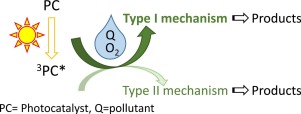Catalysis Today ( IF 5.2 ) Pub Date : 2017-10-26 , DOI: 10.1016/j.cattod.2017.10.034 R. Martinez-Haya , M.A. Miranda , M.L. Marin

|
Rose Bengal (RB) is a widely used photocatalyst due to its high quantum yield of singlet oxygen (1O2) formation. Hence, when RB has been employed for wastewater remediation, the observed photodegradation has been attributed to reaction between the pollutants and the 1O2 formed (Type II mechanism). However, RB could also react, in principle, via electron transfer (Type I mechanism). Herein, competition between Type I vs Type II oxidation has been investigated for RB in the photodegradation of emerging pollutants such as diclofenac (DCF) and acetaminophen (ACP). In parallel, the photocatalyst perinaphthenone (PN) has also been evaluated for comparison. The degree of removal achieved for both pollutants in aerated/deaerated aqueous solutions irrespective of the employed photocatalyst does not support the involvement of 1O2 as the main species responsible for removal of the pollutants. Photophysical experiments showed that the triplet excited states of RB and PN are efficiently quenched by both DCF and ACP. Moreover, 1O2 emission was also quenched by DCF and ACP. Thus the contribution of Type I versus Type II in the photodegradation has been evaluated from the experimentally determined rate constants. Nevertheless, at the upper limit for the typical concentration of emerging pollutants (10−5 M) photodegradation proceeds mainly via Type I mechanism.
中文翻译:

污染物的I型与II型光降解
玫瑰红(RB)由于其单线态氧(1 O 2)形成的高量子产率而被广泛使用。因此,当使用RB进行废水修复时,观察到的光降解归因于污染物与1 O 2之间的反应。形成(II型机制)。但是,RB原则上也可以通过电子转移反应(I型机理)。在本文中,已经研究了在双氯芬酸(DCF)和对乙酰氨基酚(ACP)等新兴污染物的光降解过程中,RB对I型与II型氧化之间的竞争。同时,还评估了光催化剂皮萘醌(PN)进行比较。不论采用哪种光催化剂,充气/脱气水溶液中两种污染物的去除程度均不支持1 O 2作为负责去除污染物的主要物质。光物理实验表明,RBF和PN的三重激发态被DCF和ACP有效地淬灭。此外,1 O2发射也通过DCF和ACP淬灭。因此,已根据实验确定的速率常数评估了I型与II型在光降解中的贡献。然而,在新兴污染物典型浓度的上限(10 -5 M)下,光降解主要通过I型机制进行。











































 京公网安备 11010802027423号
京公网安备 11010802027423号